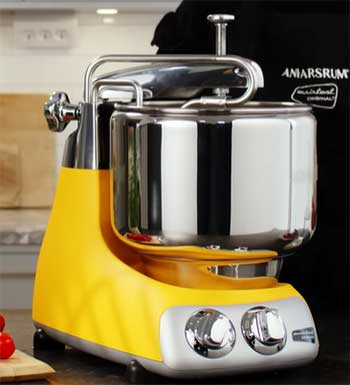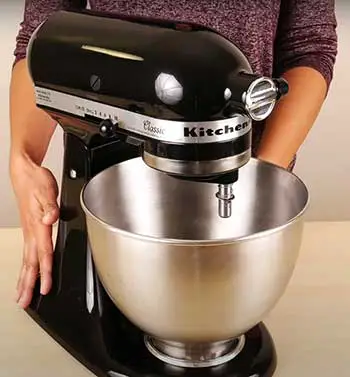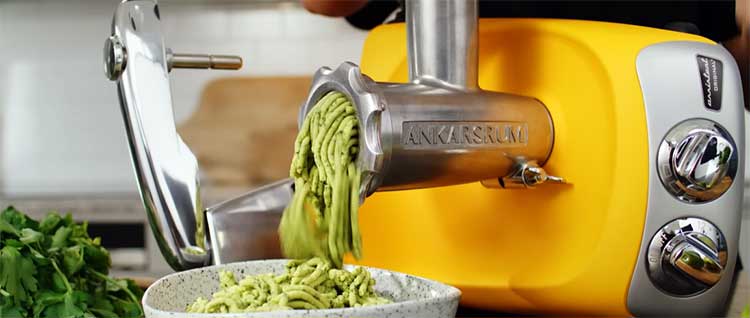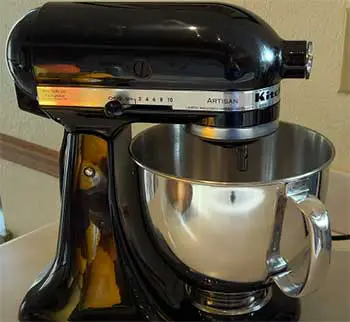As someone who’s spent countless hours in the kitchen experimenting with everything from sourdough loaves to buttercream frostings, I’m excited to share my thoughts on two standout mixers: the Ankarsrum and the KitchenAid.
This article aims to help you figure out which one fits your baking style, whether you’re a home enthusiast tackling big batches or someone who loves versatile tools for everyday recipes.
I’ll break down their strengths, weaknesses, and how they stack up, drawing from real-world use to guide your choice.
| Feature | Ankarsrum | KitchenAid |
| Motor Power | 600 watts – handles tough jobs like a champ | 325-575 watts depending on model – solid but can strain on heavies |
| Bowl Capacity | Up to 7.4 quarts – perfect for feeding a crowd | 4.5-7 quarts – great for most home needs |
| Design Style | Rotating bowl with open top – easy adds while mixing | Tilt-head or bowl-lift – classic and user-friendly |
| Key Strength | Dough kneading superstar | Attachment versatility for all tasks |
| Noise Level | Whisper-quiet even at full speed | A bit louder, like a friendly hum |
| Warranty | 7 years – built to last generations | 1-5 years – reliable but shorter |
| Price Range | $700+ – investment piece | $300-600 – more accessible entry |
| Best For | Serious bread bakers | All-around kitchen multitaskers |
Head-to-Head Comparison of Ankarsrum And KitchenAid
Now, let’s pit them against each other in key areas to see where each excels.
- Design and Build Quality

The KitchenAid’s tilt-head or bowl-lift mechanism feels familiar and intuitive, with a sleek, iconic look that’s at home in any kitchen.
I love how easy it is to swap bowls or scrape sides mid-mix.
The Ankarsrum, with its rotating bowl and fixed arm, offers superior access – no lifting heavy bowls, which is a back-saver for large loads.
Its Scandinavian minimalism is elegant, but the metal finish shows fingerprints more.
Both are built tough, but the Ankarsrum’s low-center gravity gives it an edge in stability during intense sessions.
- Performance in Mixing and Kneading
For general mixing, the KitchenAid’s planetary action ensures even results across batters and whips. I’ve creamed butter and sugar flawlessly for cakes, with speeds that ramp up smoothly. However, it can bog down on heavy doughs, requiring breaks.
The Ankarsrum shines here; its dough roller simulates professional techniques, producing silkier textures in breads. In my side-by-side tests, Ankarsrum-kneaded dough rose higher and baked with better crumb.
For cookies or frostings, KitchenAid edges out with easier handling of smaller, thicker mixes.
- Attachment Variety and Versatility
KitchenAid dominates with its vast ecosystem – over 10 attachments mean you can spiralize veggies, roll pasta, or even strain fruits. I’ve expanded mine over time, turning it into a one-stop prep station.
Ankarsrum’s attachments, while quality, are fewer and more focused on core tasks like grinding or blending. The citrus press and vegetable slicer work well, but if you want endless add-ons, KitchenAid wins for creativity in the kitchen.
- Capacity and Batch Size Flexibility
Ankarsrum’s 7.4-quart bowl handles up to 11 pounds of dough, ideal for bulk baking – I’ve prepped enough for a week’s worth of meals in one go. KitchenAid varies by model, but even the largest tops at 7 quarts, better for average households.
For small batches, KitchenAid’s smaller bowls adapt easier, while Ankarsrum requires the whisk accessory for precision.
- Noise, Heat, and Energy Use
KitchenAid generates more sound and warmth during extended runs, which I’ve noticed in marathon baking days. Ankarsrum stays cool and quiet, making it preferable for peaceful environments or long tasks.
Both are efficient, but Ankarsrum’s design minimizes energy waste.
- Price and Value Over Time
KitchenAid starts lower, around $300, offering good value for versatile use. Ankarsrum’s premium price reflects its durability – with that seven-year warranty, it’s a long-haul choice.
If you bake heavily, Ankarsrum pays off; for occasional use, KitchenAid delivers without the upfront hit.
Pros of KitchenAid Stand Mixer
I’ve relied on my KitchenAid for years, and it’s like that reliable friend who’s always ready for whatever recipe I throw at it. Let’s explore what makes it shine.
- Versatile Attachments That Expand Your Kitchen Arsenal

One thing I appreciate about the KitchenAid is how it turns into a multi-tool with just a swap of attachments.
The power hub lets you connect over a dozen options, from pasta rollers to spiralizers and even ice cream makers.
In my experience, this means I can whip up fresh fettuccine one day and grind my own burger meat the next without needing extra appliances cluttering my counters.
It’s especially handy for someone like me who enjoys experimenting with different cuisines – think shredding vegetables for coleslaw or juicing citrus for cocktails.
The attachments lock in securely, and I’ve never had one wobble during use, which gives me confidence when tackling denser mixtures.
- Wide Range of Models and Colors to Match Your Style
KitchenAid offers something for every setup, from the compact Classic series with its 4.5-quart bowl to the beefier Pro Line with 7 quarts. I went with the Artisan model in empire red because it pops in my kitchen, and with over 40 color options, you can pick one that feels personal.
This isn’t just aesthetic; it encourages me to leave it out on the counter, so I use it more often. The tilt-head design on many models makes it simple to switch bowls or add ingredients mid-mix, which saves time during busy baking sessions.
Plus, the metal construction feels sturdy – I’ve dropped mine once (oops), and it bounced back without a dent.
- Consistent Performance for Everyday Baking Tasks
When I’m mixing cake batters or whipping egg whites, the KitchenAid’s 10-speed settings let me dial in exactly what I need. The planetary mixing action ensures everything gets incorporated evenly, so no more lumps in my mashed potatoes or unmixed flour pockets in cookies.
I’ve made batches of meringue that hold stiff peaks perfectly, and for lighter doughs like pizza bases, it kneads without overworking the gluten. It’s also energy-efficient in daily use; I don’t notice it spiking my electric bill even after hours of holiday prep.
For families or casual bakers, this reliability means less frustration and more successful outcomes right from the start.
- Accessibility and Community Support
KitchenAid has been around since 1919, so there’s a huge community of users sharing tips and recipes. I’ve found inspiration from online forums where people tweak attachments for custom uses, like making sausage with the grinder.
Parts are easy to find if something wears out, and the brand’s customer service has helped me troubleshoot a sticky speed lever once. This ecosystem makes it feel less like a gadget and more like a partner in my cooking adventures.
Cons of KitchenAid Stand Mixer
That said, no mixer is perfect, and I’ve run into a few limitations with my KitchenAid that might make you pause before buying.
- Struggles with Heavy Dough Loads

If you’re into bread baking like I am, pushing the KitchenAid with stiff, high-hydration doughs can be tricky.
The motor, especially in mid-range models, heats up after prolonged kneading of large batches – I’ve had to pause sessions to let it cool.
It’s not ideal for double or triple recipes of bagels or challah, where the machine starts walking across the counter from the strain.
While it handles occasional heavy tasks, consistent pro-level use might wear it down faster than expected.
- Noise During Operation
I notice the hum turns into a noticeable whir at higher speeds, which can disrupt a quiet kitchen evening. Compared to some competitors, it’s not the quietest, and if you’re mixing while chatting or listening to a podcast, it might drown out the details.
Over time, this adds up if you bake frequently.
- Limited Capacity in Entry-Level Models
The smaller bowls on basic models max out at about 4.5 quarts, which is fine for solo or small family use but cramps my style when I’m prepping for parties.
Scaling up recipes means multiple batches, extending my time in the kitchen. Even with larger options, the bowl-lift versions feel bulkier to maneuver.
- Shorter Warranty Period
Most KitchenAid models come with a one-year warranty, extendable to five on pricier ones, but I’ve worried about long-term durability after hearing stories of gear failures. It’s solid, but without that extra peace of mind, repairs could add costs down the line.
Pros of Ankarsrum Stand Mixer

Switching gears, the Ankarsrum has impressed me with its robust build and specialized prowess. Here’s why it stands out in my trials.
- Exceptional Power for Demanding Tasks
With a 600-watt motor, this mixer powers through dense mixtures effortlessly. I’ve kneaded five kilograms of bread dough without it breaking a sweat – the torque is impressive, and it maintains speed consistently.
For bakers focused on artisan loaves or pasta dough, this means shorter mixing times and better gluten development. The bottom-drive system places the motor low for stability, so no tipping or shaking, even at full capacity.
- Innovative Rotating Bowl Design
The open-top bowl spins while tools stay fixed, which I find genius for adding ingredients on the fly without stopping. It’s 7.4 quarts, handling massive batches – think holiday cookie dough for the whole neighborhood.
This setup mimics hand-kneading more naturally, resulting in fluffier breads in my tests. Plus, the stainless steel bowl is durable and easy to clean, with a lid for proofing right in the mixer.
- Quiet and Efficient Operation
Running the Ankarsrum feels almost serene; it’s much quieter than other mixers I’ve used, letting me multitask without noise fatigue. The variable speed control is smooth, from gentle stirring to vigorous whipping, and it doesn’t overheat during long sessions.
Energy-wise, it’s efficient, which appeals to my eco-conscious side.
- Long-Term Durability and Warranty
Built in Sweden since 1940, the Ankarsrum comes with a seven-year warranty that backs its quality. I’ve seen models from decades ago still going strong in family kitchens.
The metal gears and sturdy frame suggest it’ll outlast trends, making it a worthwhile splurge for committed users.
- Specialized Attachments for Precision Work
From the dough roller that gently folds mixtures to the citrus juicer, the attachments are thoughtfully designed. I’ve used the meat grinder for homemade sausages, and it processes evenly without clogging.
The 3.5-liter whisk bowl is perfect for smaller tasks like whipping cream, adding flexibility.
Cons of Ankarsrum Stand Mixer
Despite its strengths, the Ankarsrum isn’t without drawbacks, based on my hands-on time.
- Higher Price Point: At over $700, it’s a significant investment – not impulse-buy territory. If you’re just starting out or bake sporadically, this might feel extravagant compared to more affordable options.
- Adjustment Period for New Users: The unique setup requires getting used to how the tools interact with the spinning bowl. My first few attempts at cookie dough were messy until I softened the butter properly; it’s less forgiving for stiff batters without prep.
- Fewer Color and Style Options: With limited colors like red or silver, it doesn’t offer the personalization of other brands. If aesthetics matter in your kitchen, this might not excite as much.
- Bulkier Footprint for Storage: Though compact for its capacity, the Ankarsrum’s design takes up counter space, and storing attachments separately can be a hassle if your cabinets are tight.
User Scenarios: Who Wins When?
For a busy parent mixing quick treats, KitchenAid’s ease wins. But if you’re a dedicated bread maker like me, crafting weekly loaves, Ankarsrum’s power transforms the process. In professional home setups, Ankarsrum holds up better under daily strain.

Expanding on these points, I’ve found that the choice often boils down to your primary focus.
If dough is your passion, the Ankarsrum’s innovative approach changes how you work – the roller gently folds and stretches, mimicking artisan methods that yield superior results.
I’ve baked baguettes with it that had an open crumb structure I couldn’t achieve as easily with KitchenAid.
On the flip side, KitchenAid’s attachments have let me explore beyond baking; grinding spices for curries or making fresh pasta elevates weeknight dinners.
Considering maintenance, both clean up straightforwardly, but Ankarsrum’s open design means less splatter to wipe. I’ve washed the stainless bowls in the dishwasher without issues.
Ergonomically, KitchenAid’s controls are front-facing and simple, while Ankarsrum’s knob offers infinite adjustments for fine-tuning.
In terms of innovation, Ankarsrum draws from its 80+ year history, evolving from bakery tools to home use. KitchenAid, with its century-long legacy, emphasizes accessibility. I’ve appreciated how KitchenAid integrates with smart home trends in newer models, though core functions remain timeless.
For eco-aspects, both use durable materials, but Ankarsrum’s Swedish manufacturing emphasizes sustainability. I’ve felt good about its longevity reducing waste.
Diving into specifics, let’s talk speeds: KitchenAid’s 10 settings cover everything, but Ankarsrum’s stepless control lets me match exactly to recipes – crucial for delicate emulsions.
On attachments again, KitchenAid’s pasta maker has produced silky sheets for ravioli, while Ankarsrum’s blender attachment purees soups smoothly. But for meat processing, Ankarsrum’s grinder handles tougher cuts better due to the motor.
In my kitchen tests, whipping cream: Both peak stiffly, but Ankarsrum does it faster with less aeration risk. For yeast doughs, Ankarsrum prevents over-kneading, preserving flavors.
Price-wise, factor in resale: KitchenAids hold value well due to popularity. Ankarsrum, being niche, appeals to enthusiasts.
Community-wise, KitchenAid has endless recipes; Ankarsrum’s users share specialized tips for European-style baking.
Ultimately, I’ve used both for different phases – KitchenAid for variety, Ankarsrum for depth in dough work.
Also Read: Comparison of KitchenAid Ultra Power And Classic Stand Mixers.
Frequently Asked Questions (FAQ)
For heavy dough tasks, the Ankarsrum outperforms with more power and stability. Bosch also excels in batch sizes.
Yes, they’re excellent for powerful, quiet operation and large capacities, especially for bread enthusiasts.
The KitchenAid Artisan series often tops lists for its balance of versatility, reliability, and accessibility.
Ankarsrum, a Swedish company, manufactures it since 1940.
Wrapping Up
In wrapping this up, I’ve shared my experiences with both the Ankarsrum and KitchenAid to highlight how they can elevate your baking game. Depending on whether you prioritize raw power for dough or broad versatility for daily tasks, one will likely suit you better.
I encourage you to think about your most common recipes – if it’s hearty breads, go Ankarsrum; for everything else, KitchenAid rarely disappoints. Whichever you choose, you’ll wonder how you managed without it.
Happy mixing!
